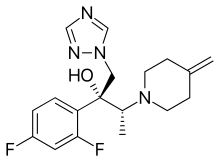Efinaconazole
Efinaconazole, sold under the brand names Jublia and Clenafin, is a triazole antifungal. It is approved for use in the United States, Canada, and Japan as a 10% topical solution for the treatment of onychomycosis (fungal infection of the nail).[1][2] Efinaconazole acts as a 14α-demethylase inhibitor.[3][4]
 | |
| Clinical data | |
|---|---|
| Trade names | Jublia, Clenafin |
| AHFS/Drugs.com | Monograph |
| MedlinePlus | a614050 |
| License data |
|
| Pregnancy category |
|
| Routes of administration | Topical (solution) |
| ATC code | |
| Legal status | |
| Legal status | |
| Identifiers | |
| |
| CAS Number | |
| PubChem CID | |
| DrugBank | |
| ChemSpider | |
| UNII | |
| KEGG | |
| ChEBI | |
| ChEMBL | |
| CompTox Dashboard (EPA) | |
| ECHA InfoCard | 100.245.862 |
| Chemical and physical data | |
| Formula | C18H22F2N4O |
| Molar mass | 348.39 g·mol−1 |
| 3D model (JSmol) | |
| |
| |
Medical uses
Efinaconazole is an azole antifungal indicated in the US for the topical treatment of onychomycosis of the toenails due to Trichophyton rubrum and Trichophyton mentagrophytes.[4]
In two clinical trials 17.8% and 15.2% of patients using efinaconazole were cured, compared to 3.3% and 5.5% of patients using a placebo.[4]
Efinaconazole is not especially effective, but it is currently the best topical treatment available, with cure rates two or three times better than the next best topical treatment, ciclopirox. It is considered a reasonable option for patients with mild cases, or patients who can not take oral treatment.[5]
History
In 2014, the U.S. Food and Drug Administration (FDA) approved the New Drug Application (NDA).[6][7] According to Valeant Pharmaceuticals International Inc CEO J. Michael Pearson they acquired Jublia through their purchase of Dow Pharmaceutical Sciences in 2008.[7]
Society and culture
Cost
In 2015, the cost of treatment with efinaconazole in the United States was said to be $2317 per nail.[8]
References
- Patel T, Dhillon S (November 2013). "Efinaconazole: first global approval". Drugs. 73 (17): 1977–1983. doi:10.1007/s40265-013-0152-x. PMID 24249649.
- Tschen EH, Bucko AD, Oizumi N, Kawabata H, Olin JT, Pillai R (February 2013). "Efinaconazole solution in the treatment of toenail onychomycosis: a phase 2, multicenter, randomized, double-blind study". J Drugs Dermatol. 12 (2): 186–192. PMID 23377392.
- Tatsumi Y, Nagashima M, Shibanushi T, et al. (May 2013). "Mechanism of action of efinaconazole, a novel triazole antifungal agent". Antimicrob Agents Chemother. 57 (5): 2405–2509. doi:10.1128/aac.02063-12. PMC 3632939. PMID 23459486.
- "Jublia- efinaconazole solution". DailyMed. 30 September 2016. Retrieved 27 April 2020.
- "A Closer Look At A New Topical Option For Onychomycosis". Retrieved 21 May 2015.
- "Drug Approval Package: Jublia topical solution (efinaconazole) NDA #203567". U.S. Food and Drug Administration (FDA). 24 December 1999. Retrieved 27 April 2020.
- "Valeant Pharmaceuticals Announces FDA Approval Of Jublia for the Treatment of Onychomycosis". Valeant Pharmaceuticals. Laval, Quebec. 9 June 2014. Archived from the original on 8 November 2015. Retrieved 1 November 2015.
- Mikailov A, Cohen J, Joyce C, Mostaghimi A (2015). "Cost-effectiveness of Confirmatory Testing Before Treatment of Onychomycosis". JAMA Dermatology: 1–6. doi:10.1001/jamadermatol.2015.4190. PMID 26716567.
External links
- "Efinaconazole". Drug Information Portal. U.S. National Library of Medicine.